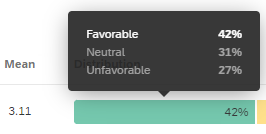We just launched our first employee experience survey. We are hoping to compare ourselves to some industry benchmarks to better understand how our employee’s experience compares to that of other companies. However, I can’t determine a best practice on which benchmarks to use. We have the option of the 75th%ile for favorability or the 75th%ile for the average score. Is there a reason to use favorability rather than the average score? Our results look better or worse depending on which benchmark we use. I’d love to find a “best practice” to pull from.
Hello
Please refer to the 2020-2022 Engagement Benchmark Overview guide on the best practices and differences between the favorability and average percentile link: 2020-2022 Engagement Benchmark Overview (qualtrics.com). In short summary, here is quick summary on what they measure.
- Percent Favorable - 75th percentile: This refers to the 75th percentile of the percent favorable scores (e.g., % Agree + % Strongly Agree) across surveys
- Average - 75th percentile: This refers to the 75th percentile of the raw mean scores across
surveys
“Top Percentiles are the threshold scores required to be in the top percentile. For example, the 75th percentile
reflects the survey score at which 75% of survey scores fall at or below. The 90th percentile reflects the score at
which 90% of survey scores fall at or below. These are sometimes referred to as high performing stretch
benchmarks but they are not recommended for first time engagement surveys” - Qualtrics EX Engagement Benchmark Availability.
I hope this link helps but this is where we decided our best practices for benchmarking.
Given the definitions you showed us above, I would say to
It will be up to you to decide whether 50th percentile or 75th percentile or 90th percentile, etc, is right for you (but again, as stated above, 90th percentile is usually considered the “stretch” goal or something that probably shouldn’t be aimed for right away).
Hope this is helpful. Good luck!
Thanks Eric. I understand what the benchmarks mean and had already gone through that deck. What I didn’t see in there was a direction on which benchmarks are preferred. Should we be looking at % favorable or the average score?
Hello
It really depends on which route you want to go. If you were to select the percent favorable 75th percentile, you would strictly be analyzing and comparing the proportion of positive responses towards a certain issue or topic from your EX-survey. Example would be comparing your Intent to Stay favorability percentage against all other companies in the same industry with the 75th percentile.
If you are going the route of the average, it is just going to compare the score of all values giving you a overall Intent to Stay score based on a raw number.
In summary, you can focus on the proportion of positive responses or use the average to compare the general feeling or your associates. It really depends on population size, the availability of data within your industry/country, and what your organization wants to analyze. In our case, we went with percent favorable.
Visually you can see it as comparing the average of 3.11 or the percent favorable of 42%. which would be pulling Strongly agree & agree (however you scale is worded and setup).

Leave a Reply
Enter your E-mail address. We'll send you an e-mail with instructions to reset your password.
